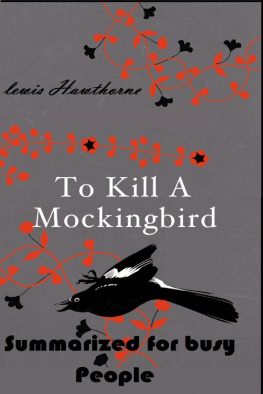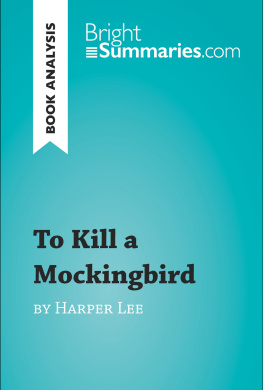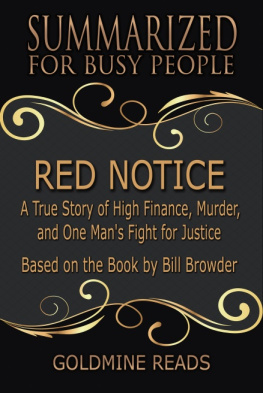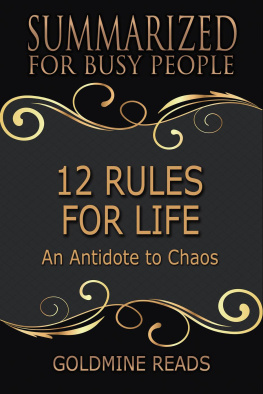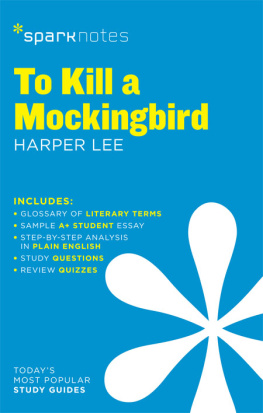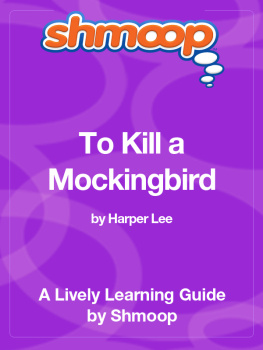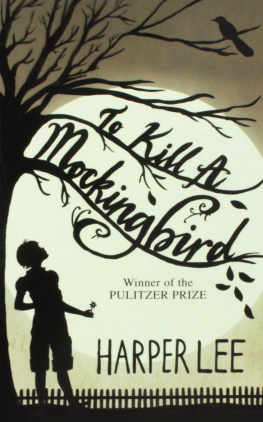Lewis Hawthorne - To Kill a Mockingbird Summarized for Busy People
Here you can read online Lewis Hawthorne - To Kill a Mockingbird Summarized for Busy People full text of the book (entire story) in english for free. Download pdf and epub, get meaning, cover and reviews about this ebook. year: 2014, publisher: Lewis Hawthorne, genre: Art. Description of the work, (preface) as well as reviews are available. Best literature library LitArk.com created for fans of good reading and offers a wide selection of genres:
Romance novel
Science fiction
Adventure
Detective
Science
History
Home and family
Prose
Art
Politics
Computer
Non-fiction
Religion
Business
Children
Humor
Choose a favorite category and find really read worthwhile books. Enjoy immersion in the world of imagination, feel the emotions of the characters or learn something new for yourself, make an fascinating discovery.
- Book:To Kill a Mockingbird Summarized for Busy People
- Author:
- Publisher:Lewis Hawthorne
- Genre:
- Year:2014
- Rating:4 / 5
- Favourites:Add to favourites
- Your mark:
- 80
- 1
- 2
- 3
- 4
- 5
To Kill a Mockingbird Summarized for Busy People: summary, description and annotation
We offer to read an annotation, description, summary or preface (depends on what the author of the book "To Kill a Mockingbird Summarized for Busy People" wrote himself). If you haven't found the necessary information about the book — write in the comments, we will try to find it.
To Kill a Mockingbird Summarized for Busy People — read online for free the complete book (whole text) full work
Below is the text of the book, divided by pages. System saving the place of the last page read, allows you to conveniently read the book "To Kill a Mockingbird Summarized for Busy People" online for free, without having to search again every time where you left off. Put a bookmark, and you can go to the page where you finished reading at any time.
Font size:
Interval:
Bookmark:
To Kill aMockingBird Summarized for Busy People
By LewisHawthorne
Copyright2013
Smashwordsedition.
This ebook is licensed for yourpersonal enjoyment only. This ebook may not be re-sold or givenaway to other people. If you would like to share this book withanother person, please purchase an additional copy for each reader.If youre reading this book and did not purchase it, or it was notpurchased for your use only, then please return to Smashwords.comand purchase your own copy. Thank you for respecting the hard workof this author.
When To Kill aMockingbird was published in 1960, it brought its youngfirst-time author, Harper Lee, a startling amount of attention andnotoriety. The novel replays three key years in the life of ScoutFinch, the young daughter of an Alabama town's principled lawyer.The work was an instant sensation, becoming a bestseller andwinning the Pulitzer Prize for fiction. Scout's narrative relateshow she and her elder brother Jem learn about fighting prejudiceand upholding human dignity through the example of their father.Atticus Finch has taken on the legal defense of a black man who hasbeen falsely charged with raping a white woman. Lee's story of theevents surrounding the trial has been admired for its portrayal ofSouthern life during the 1930s, not only for its piercingexamination of the causes and effects of racism, but because itcreated a model of tolerance and courage in the character ofAtticus Finch. Some early reviewers found Scout's narrationunconvincing, its style and language too sophisticated for a younggirl. Since then, however, critics have hailed Lee's rendering of achild's perspective as told by an experienced adultas one of themost technically proficient in modern fiction. A regional noveldealing with universal themes of tolerance, courage, compassion,and justice, To Kill a Mockingbird combined popular appealwith literary excellence to ensure itself an enduring place inmodern American literature.
Harper Lee's To Kill a Mockingbird depicts the life of its youngnarrator, Jean Louise "Scout" Finch, in the small town of Maycomb,Alabama, in the mid-1930s. Scout opens the novel as a grown womanreflecting back on key events in her childhood. The novel covers atwo-year period, beginning when Scout is six and ending when she iseight. She lives with her father, Atticus, a widowed lawyer, andher older brother, Jem (short for Jeremy). Their black housekeeper,Calpurnia tends to the children. Scout and Jem's summer playmate,Dill Harris, shares the Finch children's adventures and addsimagination and intrigue to their game playing. In the novel, wesee Scout grow in awareness and come to new understandings abouther town, her family, and herself.
During the summer before Scoutenters school, the children become fascinated with Arthur "Boo"Radley, a reclusive neighbor. Radley's father, a religious fanatic,confined Boo to the house because he was arrested for youthfulpranks as a teenager. Some years later, Boo casually stabbed hisfather in the leg with a pair of scissors, confirming people'sworst fears about him. The children are naturally afraid of andintrigued by such a "malevolent phantom," as Scout calls him. Yetthey only approach the house once, when Jem runs and touches theporch on a dare.
Scout enters first grade thefollowing September and must confront new challenges and learn newways to deal with people. She cannot understand, for instance, heryoung teacher's lack of familiarity with the town families andtheir peculiarities, such as the Cunningham children's poverty andpride. Later, Atticus explains to Scout that she must put herselfin others' places before judging them, one of the many lessons shelearns by making mistakes.
With summer's return, Dillarrives and the children's absorption with Boo Radley begins againin earnest. Ultimately, they attempt to look in the house to seeBoo, but a shotgun blast from Nathan Radley, Boo's brother, drivesthem off. In their panic, Jem catches his overalls in the Radleyfence and must abandon them. Later that night, he returns toretrieve them and finds them neatly folded on the fence with theripped fabric poorly resewn.
Their contact with Boo Radleycontinues into the school year. Before the previous summer, Scoutand Jem had discovered gum and Indian head pennies in a knot-holedtree by the Radley house. Now more objects begin to appear in theknothole, including replicas of Scout and Jem carved in soap. Theydecide to leave a note for whoever is leaving the objects, butbefore they can, Nathan Radley fills the hole with cement,upsetting Jem.
Scout soon encounters troubleat school when a schoolmate condemns Atticus for "defendingniggers." Atticus confirms that he is defending a black man namedTom Robinson, who is accused of raping a white woman, and that hisconscience compels him to do no less. He warns her that she willencounter more accusations of this kind and to remember thatdespite their views, the people who cast slurs at them are stilltheir friends. Atticus later tells his brother Jack that he hopeshe can guide his children through this time without them becomingbitter and "without catching Maycomb's usual disease" ofracism.
That Christmas, Atticus givesthe children air rifles and admonishes them to shoot nomockingbirds. Miss Maudie Atkinson, their neighbor, explainsAtticus's reasons when she says that "Mockingbirds don't do onething but make music for us to enjoy." Hence, it is a sin to killthem. At this time, the children feel disappointed in Atticusbecause he is old (almost fifty) and does nothing of interest. Theysoon learn, however, about one of their father's unique talentswhen he shoots a rabid dog that threatens the neighborhood, killingthe beast with one shot. The neighbors tell them that Atticus isthe best shot in the county, he just chooses not to shoot a gununless he must. Scout admires Atticus for his shooting talent, butJem admires him for his gentlemanly restraint.
The family's involvement in TomRobinson's trial dominates Part Two of the novel. One personalinconvenience of the trial is the arrival of Aunt Alexandra,Atticus's sister, who comes to tend to the family. Scout finds herpresence unwelcome because Aunt Alexandra disapproves of hertomboyish dress and activities and tries to make Scout wear dressesand attend women's socials.
The time for the trial arrives,and Atticus guards the jail door the night Tom Robinson is broughtto Maycomb. The children, including Dill, sneak out to watch overhim and soon become involved in a standoff. Car loads of men driveup and demand that Atticus let them have Tom Robinson, and hegently refuses. Scout recognizes a schoolmate's father, Mr.Cunningham, and asks him polite questions about his legal debt toAtticus, who did work for him, and about his son. Scout's innocentquestioning of Mr. Cunningham shames him, and he convinces the mento leave.
The children also sneak to thecourthouse to attend the trial. They sit in the balcony with theblack townspeople because no seats are available on the groundfloor. Atticus's questioning of Bob Ewell and Mayella Ewell, bothof whom claim Tom Robinson beat and raped Mayella, reveals theirlies. Mayella was beaten primarily on the right side of her body bya left-handed man. By having Bob Ewell sign his name, Atticus showshim to be left-handed. Tom Robinson's left arm, however, iscrippled from a boyhood accident. Tom's story rings truer. Hecontends that Mayella invited him into the house and tried toseduce him, a story made credible by Mayella's and Tom'sdescriptions of her lonely life. Tom resisted her advances, butbefore he could leave Bob Ewell discovered them. Tom ran and Ewellbeat Mayella. To avoid social disgrace, the Ewells claimed Tom hadraped her.
Despite the evidence, Tom isconvicted. Atticus has expected this verdict and believes he canwin on appeal. Jem has difficulty accepting the injustice of theverdict. Others, however, remain angry over Atticus's sinceredefense of Robinson, particularly Bob Ewell. Ewell confrontsAtticus, threatens him, and spits on him. Soon after, TomRobinson's story ends in tragedy as he is shot trying to escapefrom prison. He ran because he believed he could find no justice ina white dominated legal system.
Next pageFont size:
Interval:
Bookmark:
Similar books «To Kill a Mockingbird Summarized for Busy People»
Look at similar books to To Kill a Mockingbird Summarized for Busy People. We have selected literature similar in name and meaning in the hope of providing readers with more options to find new, interesting, not yet read works.
Discussion, reviews of the book To Kill a Mockingbird Summarized for Busy People and just readers' own opinions. Leave your comments, write what you think about the work, its meaning or the main characters. Specify what exactly you liked and what you didn't like, and why you think so.

